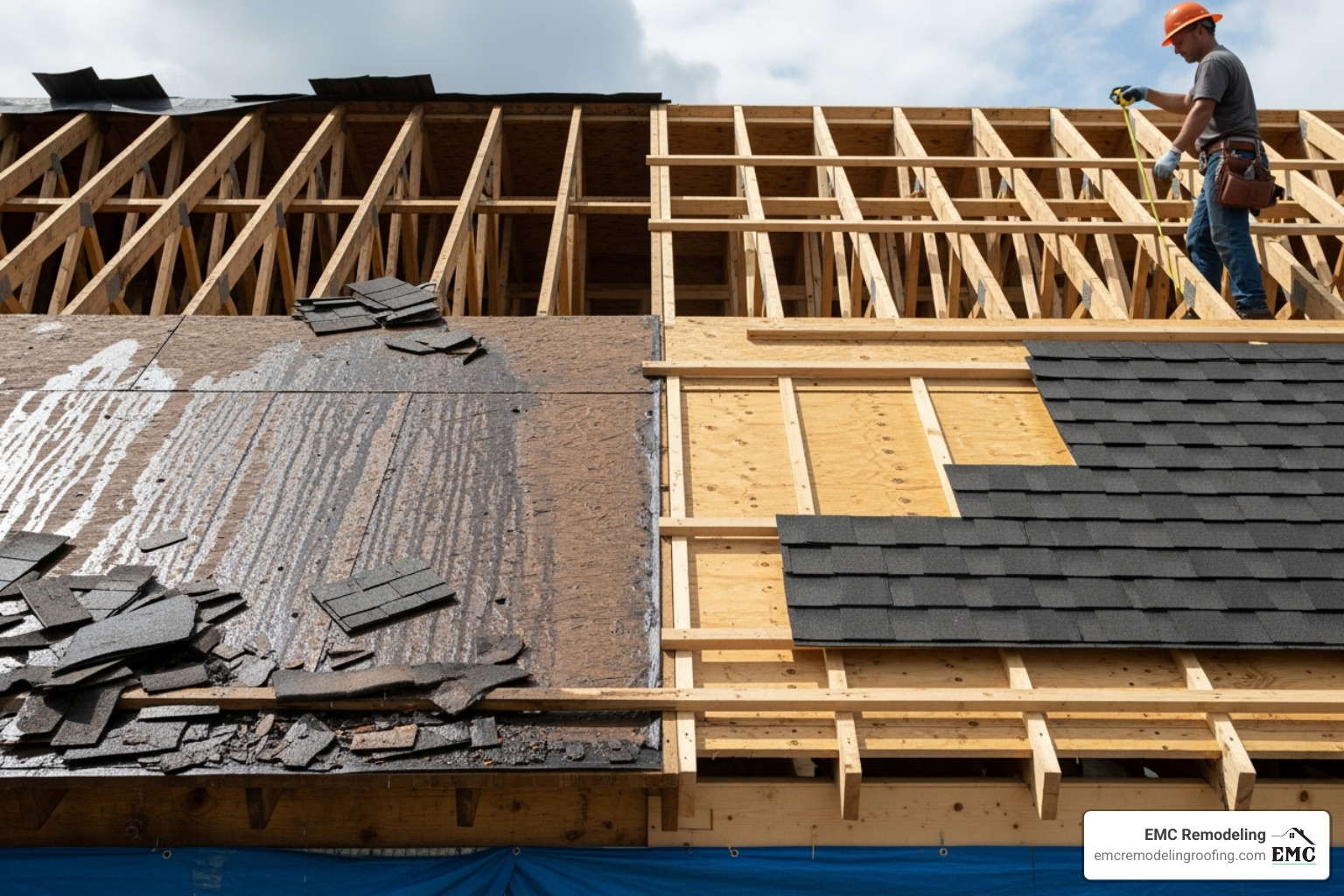Why Understanding Full Roof Structure Replacement Costs Matters
The cost to replace entire roof structure can range from $14,000 to over $50,000, depending on your home’s size and the extent of structural damage. This major investment goes far beyond simple shingle replacement—it involves rebuilding your roof’s entire framework. Unlike a simple roof replacement that only addresses surface materials, a full structural rebuild involves tearing down to the bones and rebuilding everything from rafters to shingles.
Quick Cost Breakdown:
- Roof framing: $6-$9 per square foot
- Roof decking/sheathing: $2.50-$6.00 per square foot
- Complete structure replacement: $14,000-$32,000 (before final roofing material)
- Labor costs: 40-60% of total project cost
- Additional expenses: Permits ($50-$500), disposal ($200-$500), unexpected repairs (budget 10-20% extra)
The average cost to re-frame an entire roof ranges from $14,000 to $32,000 before adding the final roofing material, which can double or triple your total investment. I’m Matthew Runyon, President of EMC Remodeling & Roofing. With over 15 years in the industry, I’ve guided countless Central Texas homeowners through these complex decisions, because educated homeowners make better choices and avoid costly surprises.
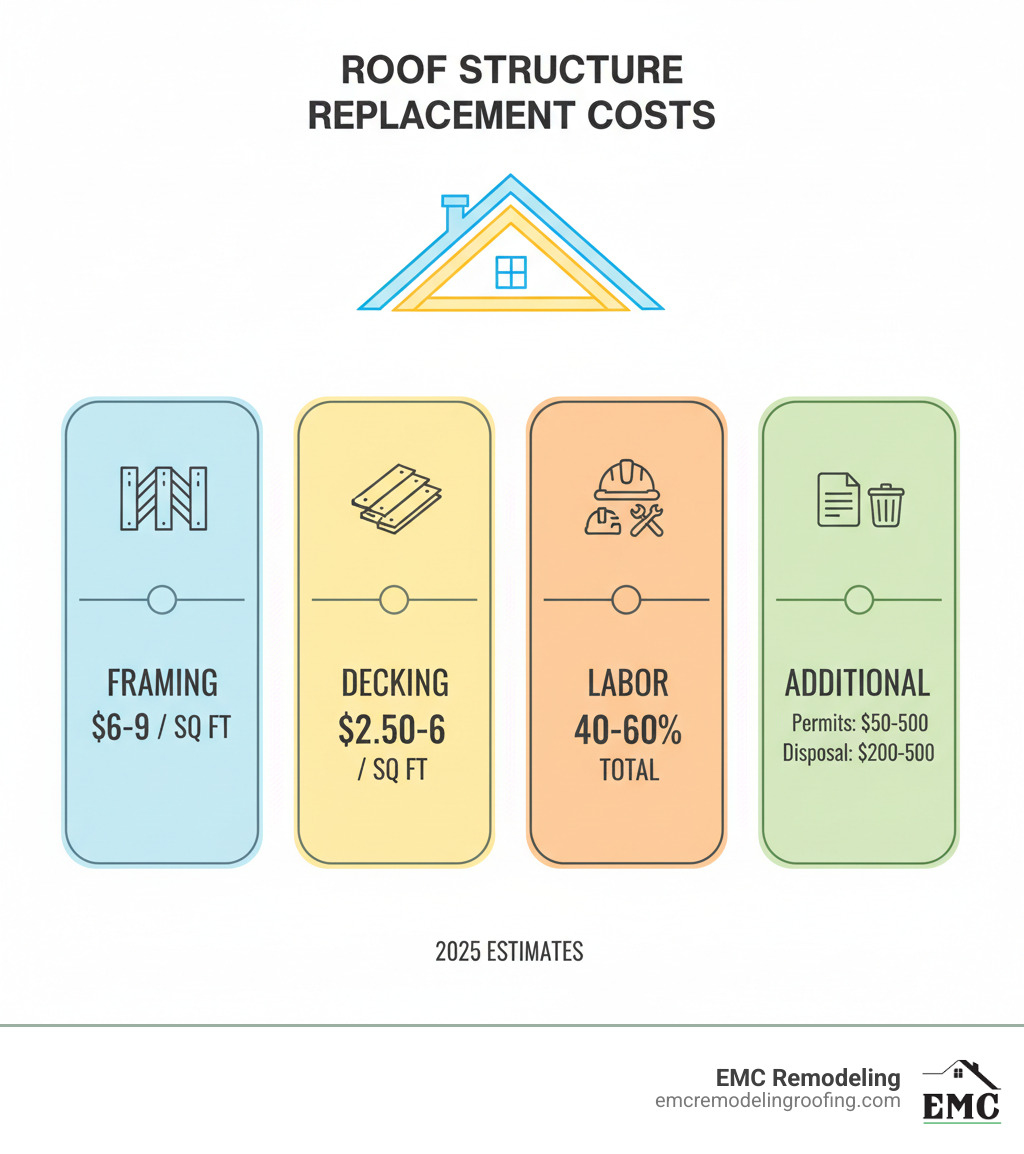
Deconstructing the Quote: What’s Included in a Full Roof Structure Replacement?
When contractors discuss the cost to replace entire roof structure, they are referring to rebuilding your roof’s entire skeleton. Re-framing an entire roof averages $14,000 to $32,000 before you even add the final roofing material. This complete reconstruction ensures your home’s safety and structural integrity for decades.
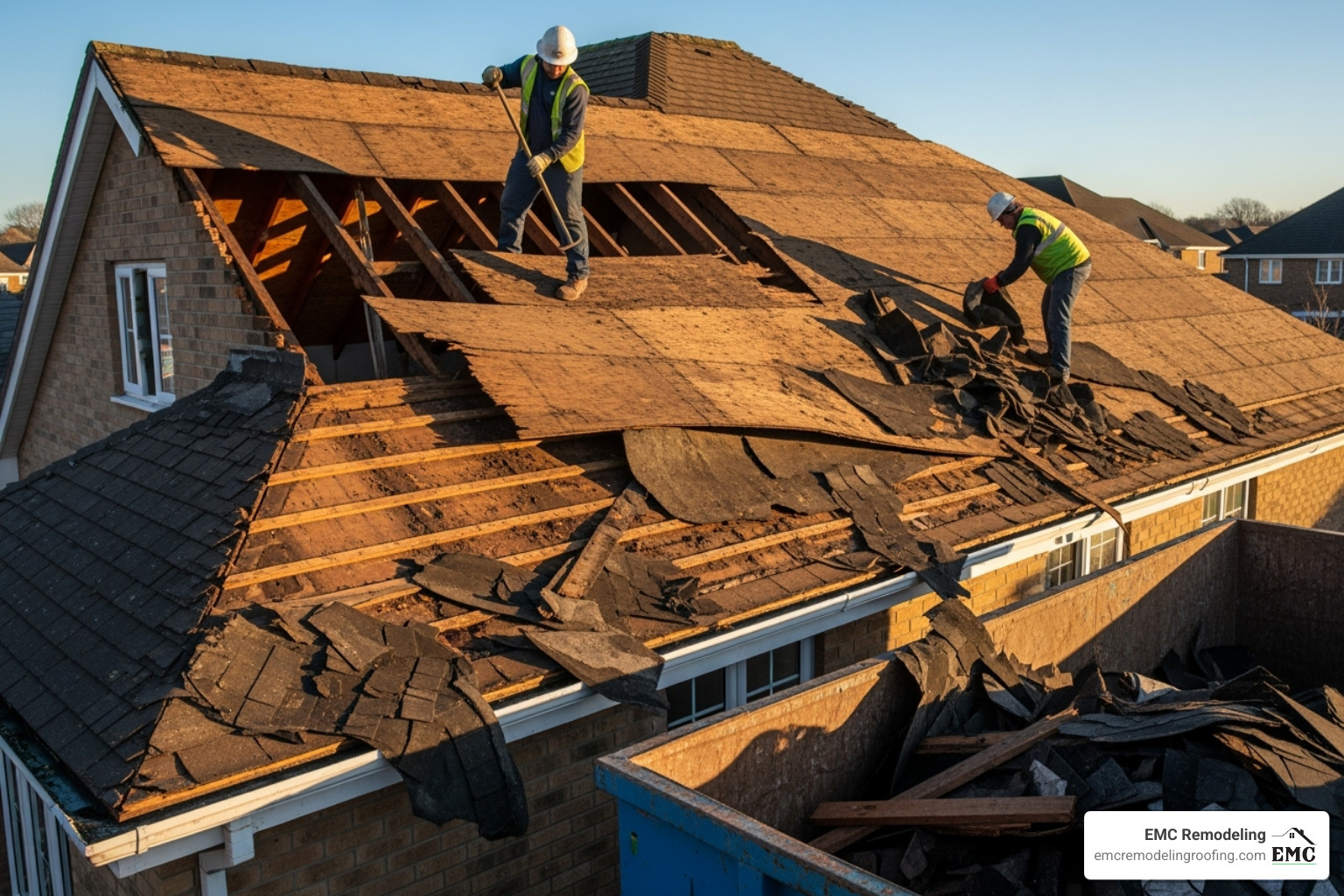
A full roof structure replacement involves several critical components:
- Roof framing (rafters or trusses): This forms the backbone that carries the roof’s weight. Rafters offer design flexibility but require more skilled labor, while pre-fabricated trusses install faster and can save money.
- Roof decking (sheathing): Typically plywood or OSB boards fastened to the framing, creating a solid foundation for all other layers.
- Underlayment: A crucial waterproof barrier that keeps moisture from reaching your home’s interior.
- Shingles or metal panels: The visible layer providing protection and curb appeal.
- Labor costs: Structural work requires expertise and safety training, so skilled roofers command premium wages.
- Demolition and disposal: Safely removing damaged materials and hauling away debris.
For a detailed breakdown of each step, check out our Complete Roof Replacement Guide.
Signs You Need More Than Just Shingles
While most homeowners hope they just need new shingles, widespread damage often requires a complete rebuild. If you notice these red flags, an emergency roof repair inspection is critical.
- Sagging roof deck: Visible dips or bouncy spots indicate compromised structural integrity.
- Visible rafter damage: Cracked or rotted beams in your attic mean the support system is failing.
- Extensive leaks: Water damage in multiple rooms suggests a systemic failure, not just a few loose shingles.
- Mold in your attic: This reveals chronic moisture problems that have likely damaged the wood framing.
- Cracked interior walls: Cracks near the upper floors can signal structural movement from a compromised roof.
- Major storm damage: Severe weather can impact structural elements even if surface damage seems minor.
Ignoring these signs makes the eventual repair more expensive and potentially dangerous.
The Core Components: Framing and Decking Costs
The “structure” itself consists of framing (rafters or trusses) and decking (the sheathing layer). Framing costs average $6 to $9 per square foot, while replacing the roof deck adds another $2.50 to $6.00 per square foot.
For a typical 1,500 square foot roof, re-framing alone can cost $8,672 to $15,778. Complex roof designs with multiple angles or dormers push costs toward the higher end. While individual rafter replacement is possible for localized damage ($5 to $14 per square foot), widespread issues usually require a complete replacement. Truss systems are an efficient alternative, using less lumber and installing faster to reduce labor costs.
When choosing between plywood versus OSB decking, you’re balancing cost and performance. Plywood costs more but offers superior water resistance, while OSB is a popular budget-friendly choice. The cost to replace roof decking on a 1,000 square foot roof is typically $2,000 to $5,000, depending on material and local codes. For significant structural concerns, a structural engineer assessment is recommended to ensure code compliance, especially when switching to heavier materials like tile.
Key Factors Driving the Cost to Replace Entire Roof Structure
Multiple variables determine the final cost to replace entire roof structure, from roof size to design complexity. Labor alone can account for up to 60% of the total project cost, so understanding these factors helps you evaluate your quote for Roofing and Repair needs.
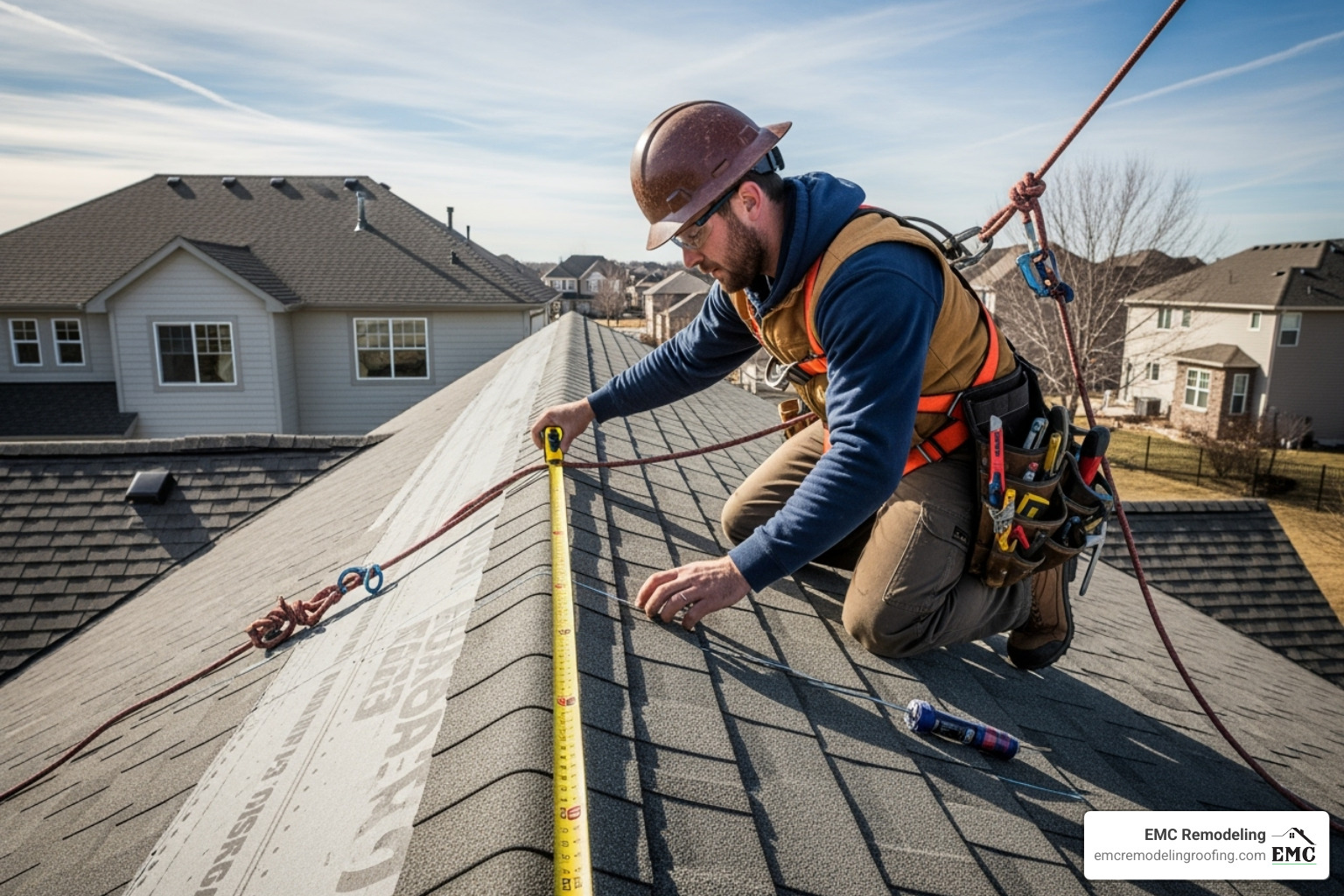
Key cost drivers include:
- Roof Size: A larger roof requires more materials and labor.
- Roof Pitch & Complexity: Steep or complex roofs with dormers and valleys are more challenging and dangerous to work on, increasing labor time.
- Material Choice: Costs vary widely from budget-friendly asphalt to premium slate.
- Labor Rates: These vary by region, contractor experience, and project skill requirements.
- Accessibility: Difficult-to-access roofs may require specialized equipment, adding to the cost.
- Property Location: This influences material availability and permit requirements.
How Roof Size and Pitch Impact Your Bottom Line
A larger, steeper roof requires more materials, specialized safety equipment, and significantly more labor. A roof over 2,000 square feet can cost 10-15% more than a smaller one, and a steep pitch can add another 20-30% to your total bill.
Roofing square footage calculation is done in “squares” (100 sq. ft.). We measure the actual roof surface, which is always larger than the home’s footprint due to pitch and overhangs. The difference between low-slope versus steep-slope roofs is dramatic for labor. Steep-slope roofs require our crews to use safety harnesses, ropes, and other fall protection, which increases labor hours. There is also a higher material waste factor (10-15%) on complex roofs due to the number of cuts required.
The Labor Equation: Why Experience Costs More
When investing in a structural replacement, you’re paying for expertise. A contractor’s experience and reputation influence the cost, but reputable roofing companies in Temple, TX provide warranties and insurance that protect your investment.
Licensed and insured contractors cost more because they carry comprehensive insurance, protecting you from liability. Our workmanship warranties mean we stand behind our installation. While an experienced crew may have higher hourly rates, their crew size and efficiency often lead to faster project completion and superior results. Regional labor rates account for 40-60% of the total cost, making the contractor’s skill a critical factor. Professional project management is also essential to coordinate details and prevent costly delays.
Material Breakdown: Cost vs. Lifespan for Texas Homes
Choosing the right material for the Texas climate is a balance between upfront cost, durability, and performance. The extreme heat, severe storms, and high UV exposure in Central Texas demand resilient materials. For example, metal roofing can last over 50 years and may lower energy bills by reflecting heat. Your material choice will significantly impact both your immediate investment and long-term satisfaction. For custom options, explore our Residential Roofing Services Near Me.
| Material Type | Cost per Sq. Ft. (Installed) | Lifespan in Texas | Pros | Cons |
|---|---|---|---|---|
| Asphalt Shingles | $3 – $10 | 20-30 years | Most affordable, wide variety, easy installation, good hail resistance (certain types). | Shorter lifespan, can degrade in extreme heat/UV, susceptible to wind damage if not properly installed. |
| Metal Roofing | $8 – $25 | 40-70+ years | Exceptional durability, energy-efficient, fire-resistant, low maintenance, recyclable, withstands high winds. | Higher upfront cost, can be noisy during rain (depending on installation), dents possible, specialized installation. |
| Clay & Concrete Tile | $10 – $50 | 50-100 years | Extremely durable, long lifespan, fire-resistant, excellent thermal insulation, unique aesthetic. | Very heavy (may require structural reinforcement), fragile if walked on, high upfront cost, specialized installation. |
| Slate Roofing | $15 – $50 | 75-150+ years | Best longevity, luxurious appearance, fireproof, waterproof, highly durable, low maintenance. | Highest upfront cost, very heavy (requires significant structural support), fragile during installation, difficult to repair. |
| Wood Shakes/Shingles | $10 – $20 | 15-30 years | Natural, rustic aesthetic, good insulation properties. | Shorter lifespan, requires frequent maintenance, susceptible to fire, mold, and insects, can warp/split. |
Architectural Shingles are a popular choice, offering better wind resistance than basic 3-Tab Shingles, which is crucial for Texas weather. Standing Seam Metal is also gaining popularity for its long-term energy savings. Clay & Concrete Tile offers excellent insulation but is very heavy, meaning your structure might need reinforcement, adding to the overall cost to replace entire roof structure.
Most Cost-Effective Options for a Full Roof Structure Replacement
Asphalt shingles are the most budget-friendly option, costing $4 to $8 per square foot installed with a 20-30 year lifespan. When you’re already investing in structural replacement, this material provides solid performance without breaking the bank.
- 3-Tab Shingles are the most economical choice with 20-25 year warranties.
- Architectural Shingles offer a dimensional look, improved durability, better wind resistance, and 30-year warranties.
Proper attic ventilation is key for asphalt shingles in Texas to help them reach their full lifespan. Always read Warranty Options carefully, as some are prorated while others offer full replacement for a set period.
Premium Materials and Their Long-Term ROI
While materials like metal ($8-$16/sq. ft.) or slate ($15-$30/sq. ft.) have a high initial cost, they can last 50-100+ years and increase home value. A new roof can yield a return on investment of nearly 60% according to the 2024 Cost Vs. Value Report.
The long-term benefits are significant. Energy Efficiency from metal roofing can reduce cooling costs by 10-25%. Many Insurance Discounts apply to fire-resistant materials like metal and slate. These roofs also boost Home Resale Value due to their longevity and Low Maintenance needs. While Slate Roofing has the highest upfront cost, its 75-150 year lifespan makes its cost-per-year of ownership competitive with cheaper materials that require multiple replacements.
Beyond the Basics: Hidden Costs and Add-Ons
A quote for the cost to replace entire roof structure should include more than just framing and shingles. Be aware of additional line items that can significantly affect your total investment.
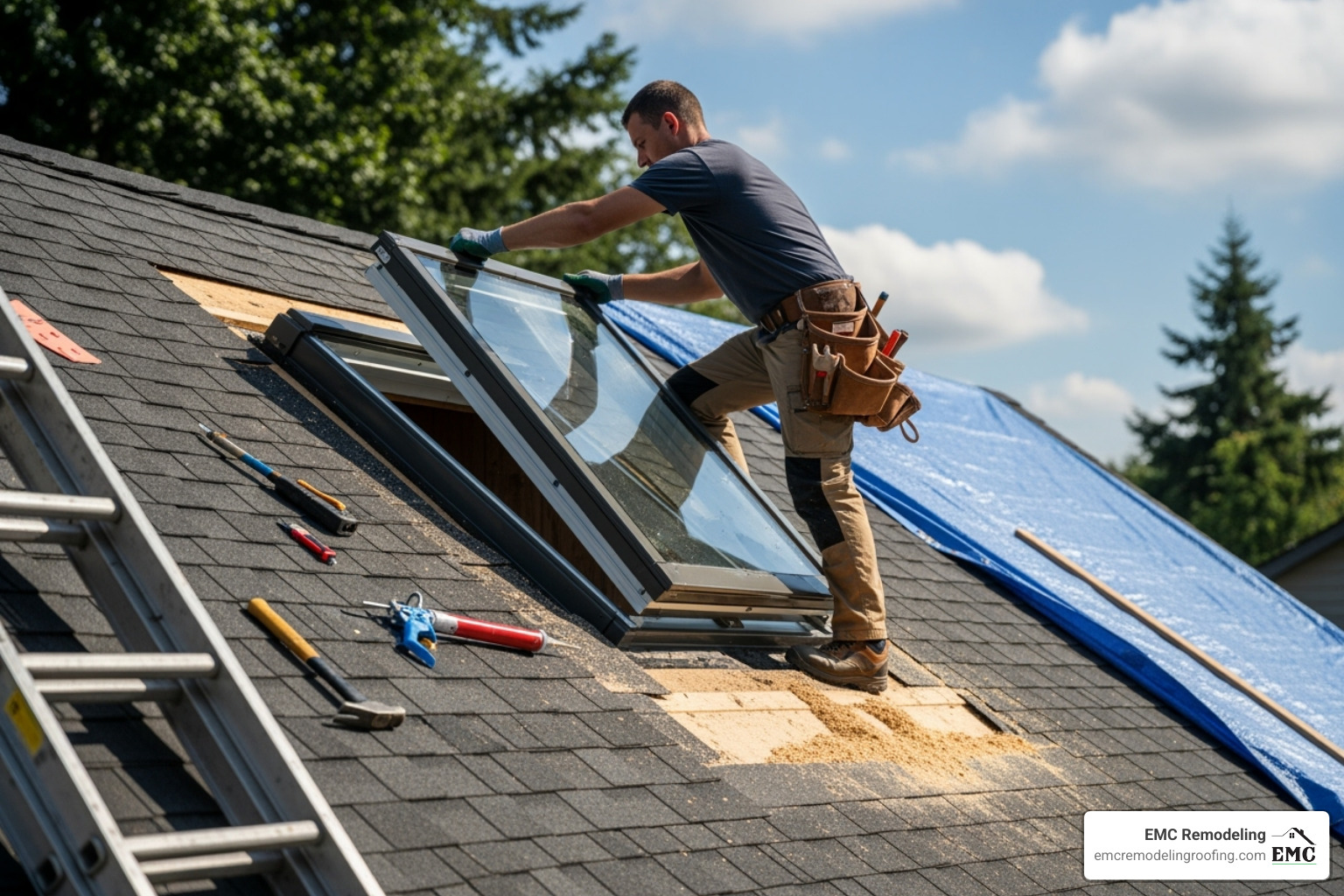
Essential add-ons that are often overlooked include:
- Permits and inspections to ensure code compliance.
- Debris removal and dumpster fees for hauling away old materials.
- Underlayment and insulation for moisture protection and energy efficiency.
- Skylights, which are best installed during a full replacement.
- Chimney flashing to prevent leaks at tricky intersections.
- Gutters and eavestroughs to ensure proper water drainage.
- Attic ventilation to extend the life of your new roof.
For comprehensive Roof Repair and Replacement services, we provide transparent quotes to avoid unwelcome surprises.
Permits, Disposal, and Unexpected Repairs
Permits can cost up to $500, and dumpster rental for debris can add another $200-$500. It is wise to budget an extra 10-20% for unforeseen issues like hidden water damage or pest infestations found during demolition.
Building permits are required for most structural roofing projects in Central Texas to ensure safety and code compliance. Skipping them can cause issues when selling your home or filing an insurance claim. Landfill fees vary based on the amount of debris. If your home was built before 1980, asbestos-containing materials may be present, requiring special and more costly disposal.
The biggest variables are unexpected repairs finded after demolition. Rotted fascia and soffit repair is common, as are issues requiring electrical work for new vents. We are familiar with local requirements, including specific codes for Belton TX Roofing projects. That 10-20% contingency budget is the difference between a smooth project and a financial shock.
Frequently Asked Questions about Roof Structure Replacement
When is it more cost-effective to repair a roof versus replacing the entire structure?
A targeted roof repair is cost-effective for isolated damage on a roof under 15 years old, typically costing $300 to $1,500. However, replacement is the better investment when dealing with widespread structural issues like a sagging roofline, multiple leaks, or damage to the underlying decking and trusses. If your roof is over 20 years old or repair costs approach 30% of a full replacement, a complete replacement is more financially sound than a cycle of continuous, costly patchwork.
What should I look for when getting quotes from roofing contractors?
When getting quotes for the cost to replace entire roof structure, look for these key items to protect your investment:
- Itemized Breakdowns: A quality quote should separate costs for materials, labor, permits, and disposal for clear comparison.
- Credentials: The contractor must be fully licensed and insured (general liability and workers’ compensation). Ask to see current certificates.
- Workmanship Warranties: Reputable contractors offer warranties (typically 5-10 years) on their installation, which is separate from the manufacturer’s material warranty.
- Realistic Pricing: Be wary of extremely low bids. They often indicate substandard materials, cut corners, or hidden charges that will appear later.
- Process for Unexpected Issues: A professional will have a clear, contractually-outlined process for handling hidden damage finded during demolition.
What is the typical timeframe for a complete roof structure replacement?
A complete roof structure replacement is a major construction project that typically ranges from one to four weeks. The final timeline depends on several factors:
- Size and Complexity: A simple gable roof on an average-sized home may take 1-2 weeks, while a complex roofline can extend the project to 3-4 weeks.
- Weather: In Central Texas, summer heat and unexpected storms can cause delays.
- Material Choice: Standard asphalt shingles install faster than premium materials like metal or tile, which require more precision.
- Extent of Damage: Uncovering additional rot or compromised rafters during demolition will add time to the project.
A typical project involves 1-2 days for demolition, 3-7 days for framing and decking, and 2-3 days for underlayment and roofing material installation, followed by cleanup and inspection.
Get a Fair and Honest Quote for Your Roof
Facing a high cost to replace entire roof structure can be overwhelming, but knowledge is your best defense against overpricing and shortcuts. Understanding that roof framing costs $6-$9 per square foot and labor accounts for 40-60% of the total helps put the investment into perspective. You’re not just buying materials; you’re ensuring the structural integrity that protects your home.
A full roof structure replacement is a complex project. At EMC Remodeling, we believe in complete transparency. When we provide a roof replacement quote, we break down every component, so you never find hidden charges. As a family-operated business, you work directly with the owners, ensuring accountability from start to finish.
Our 15+ years of experience in Central Texas means we understand the challenges of our climate, from scorching heat to sudden hailstorms. We stand behind our work with comprehensive warranties and full licensing and insurance. This investment isn’t just about solving a problem today—it’s about protecting your family and your home’s value for decades. If you’re facing structural roof damage or want an honest assessment, we’re here to help.
